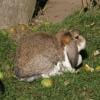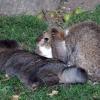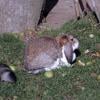There are many different species of rabbit, but they are believed to originate from Spain. All breeds of domestic rabbit originate from the European rabbit.
Rabbits were introduced into Britain by the Normans. Most non-domestic rabbits live underground in burrows or warrens, as opposed to hares which live in simple nests above the ground, and are generally larger than rabbits with longer ears.
Male rabbits are called ‘bucks’ and females ‘does’. Young rabbits are called ‘kits’, although ‘leverets’ is also sometimes used, which technically is the term for young hares. A group of young rabbits is referred to as a ‘kindle’ or ‘litter’, whilst a group of adult rabbits can be classed as a ‘bury’, ‘colony’, ‘herd’ or ‘trace’.
Rabbits are generally sociable and usually live in groups although males (bucks) kept together will often fight. Although rabbits and guinea pigs will “accept” each other as companions, the habit of a rabbit to playfully jump when happy means that its powerful hind legs can cause unintentional serious internal injury.
Rabbits are generally nocturnal, and relatively silent, although they make a loud foot thump to indicate alarm or aggression. Scent plays an important role in their communication – they possess glands throughout their body which they rub on objects to mark territory and convey identity and social status. When they face danger, they tend to freeze or hide under cover, but if chased will engage in quick, irregular movement to evade and confuse predators. Their long hind legs and a strong pelvic girdle give them great speed and agility.
ConservationStatus
Least Concerned
Near Threatened
Vulnerable
Endangered
Critically Endangered
Extinct In The Wild



